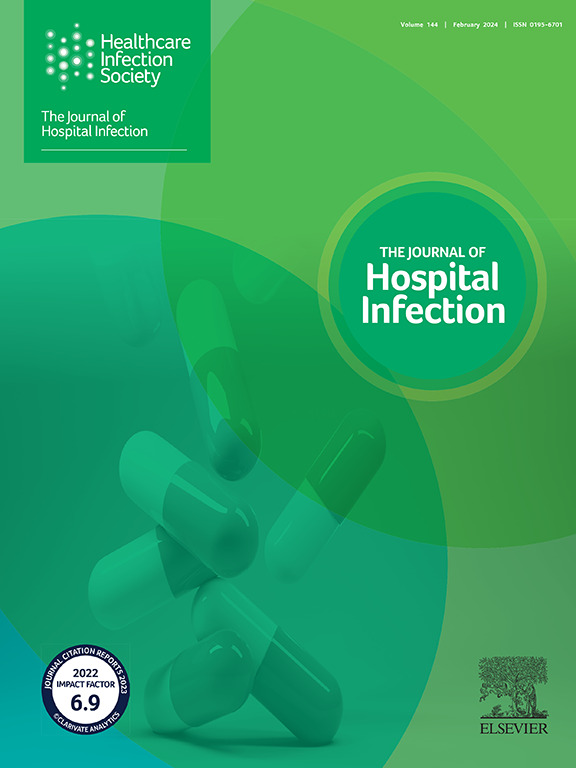保健厕所的活菌群是什么?
IF 3.1
3区 医学
Q1 INFECTIOUS DISEASES
引用次数: 0
摘要
背景:医院的冲水厕所满足工作人员和病人的需要,包括残疾人和男女共用的设施。最近引入的男女通用厕所凸显了不同厕所设施之间潜在的微生物风险。本项目旨在建立各类卫生保健厕所的可培养微生物群。方法:系统取样,采用定量和定性微生物学在多站点纵向研究。在三家医院检查了男/女工作人员和病人的手触点、低点(地板)和高点(天花板)、男女通用和残疾人设施。测定好氧菌落计数(ACC),同时鉴定主要病原菌(金黄色葡萄球菌、肠杆菌科、肠球菌、窄养单胞菌、不动杆菌和真菌)。对细菌病原体进行抗菌药物敏感性检测。结果:各试验点均存在预期的环境菌群和皮肤菌群。地板上的生物负担最重,其次是天花板。所有厕所的手触点最干净(2)(p=0.003),女厕所的手触点比男厕所干净(p=0.008)。总体生物负荷最高的是无性别厕所(12cfu /cm2),其次是男厕所。高处的植物群与地面的几乎相同。细菌病原体,包括耐药细菌,集中在患者地板上,80%分离到ACC>2.5 cfu/cm2。8个嗜麦芽窄养单胞菌中有7个来自中性厕所。金黄色葡萄球菌主要分布在男性工作人员和残疾人厕所的地板和手接触部位(p=0.02和p)。结论:清洁频率应针对较高的生物负担(男女通用)和病原体风险(病人厕所)进行建模。地板和天花板上也有类似的植物群,说明冲水时出现了雾化。这些数据为浴室设计、指定和净化操作提供了依据。本文章由计算机程序翻译,如有差异,请以英文原文为准。
What is the viable microbiome of the healthcare toilet?
Background
Flushing water toilets in hospitals cater for staff and patients, including disabled and unisex facilities. The recent introduction of unisex toilets has highlighted potential microbiological risks between different bathroom facilities.
Aim
This project sought to establish the cultivable microbiome in all types of healthcare toilet.
Methods
Systematic sampling was performed using quantitative and qualitative microbiology within a multi-site longitudinal study. Hand-touch sites, low sites (floors) and high sites (ceilings) in male/female staff and patient, unisex and disabled facilities were screened in three hospitals. Aerobic colony count (ACC) was determined alongside identification of key pathogens (Staphylococcus aureus, Enterobacterales, enterococci, stenotrophomonas, acinetobacter and fungi). Bacterial pathogens were tested for antimicrobial susceptibilities.
Findings
Expected environmental and skin flora were present at all sites. Bioburden was heaviest on floors, closely followed by ceilings. Hand-touch sites were cleanest (<2.5 cfu/cm2) in all toilets (P=0.003), with those in female toilets cleaner than in male toilets (P=0.008). Highest bioburden overall (>12 cfu/cm2) occurred in unisex toilets, followed by male toilets. Flora at high sites was almost identical to that on floors. Bacterial pathogens, including resistant bacteria, were concentrated on patient floors, with 80% isolated alongside ACC>2.5 cfu/cm2. Seven of eight Stenotrophomonas maltophilia were recovered from gender-neutral toilets. S. aureus predominated on floors and hand-touch sites in male staff and disabled toilets (P=0.02 and P<0.001, respectively).
Conclusion
Cleaning frequencies should be modelled against higher bioburden (unisex) and risk of pathogens (patient toilets). Similar flora on floors and ceilings suggested aerosolization during flushing. The data provides evidence to inform bathroom design, designation and decontamination practices.
求助全文
通过发布文献求助,成功后即可免费获取论文全文。
去求助
来源期刊

Journal of Hospital Infection
医学-传染病学
CiteScore
12.70
自引率
5.80%
发文量
271
审稿时长
19 days
期刊介绍:
The Journal of Hospital Infection is the editorially independent scientific publication of the Healthcare Infection Society. The aim of the Journal is to publish high quality research and information relating to infection prevention and control that is relevant to an international audience.
The Journal welcomes submissions that relate to all aspects of infection prevention and control in healthcare settings. This includes submissions that:
provide new insight into the epidemiology, surveillance, or prevention and control of healthcare-associated infections and antimicrobial resistance in healthcare settings;
provide new insight into cleaning, disinfection and decontamination;
provide new insight into the design of healthcare premises;
describe novel aspects of outbreaks of infection;
throw light on techniques for effective antimicrobial stewardship;
describe novel techniques (laboratory-based or point of care) for the detection of infection or antimicrobial resistance in the healthcare setting, particularly if these can be used to facilitate infection prevention and control;
improve understanding of the motivations of safe healthcare behaviour, or describe techniques for achieving behavioural and cultural change;
improve understanding of the use of IT systems in infection surveillance and prevention and control.
 求助内容:
求助内容: 应助结果提醒方式:
应助结果提醒方式:


